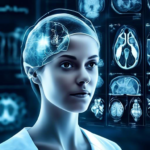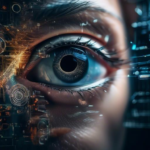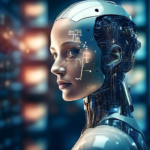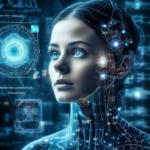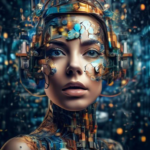In the blink of an eye, the world can change dramatically. Imagine that within those milliseconds, a computer deciphers intricate scenes, enhances visual clarity, and even recognizes faces—all in real-time. This isn’t a distant dream but the vibrant reality sculpted by AI-driven image processing. Picture a realm where security systems become flawlessly vigilant, medical diagnostics leap forward with unparalleled precision, and creative expressions through photography and filmmaking reach astounding new heights. Welcome to the fascinating world of real-time image processing powered by artificial intelligence, where yesterday’s science fiction is today’s breakthrough. Let’s embark on this journey to explore how AI is not just interpreting images as they come, but transforming the way we perceive and interact with our visual universe, one frame at a time.
Table of Contents
- Harnessing AI: A Revolution in Real-Time Image Processing
- Unraveling the Basics: Essential Components of AI-Powered Image Processing
- Real-Time Magic: Speed and Precision in Image Analysis
- Cutting-Edge Algorithms: The Heartbeat of Modern Image Processing
- Navigating Challenges: Overcoming Obstacles in Real-Time Applications
- Building Smarter Systems: Integrating AI with Existing Technologies
- Ensuring Ethical Practices: Responsible Use of AI in Image Processing
- Boosting Accuracy: Fine-Tuning AI Models for Optimal Performance
- In Summary
Harnessing AI: A Revolution in Real-Time Image Processing
The power of artificial intelligence is transforming real-time image processing, allowing for previously unimaginable capabilities. **AI-driven techniques** such as convolutional neural networks (CNNs) and deep learning algorithms have dramatically enhanced how we analyze, interpret, and utilize image data. These technologies enable rapid scene understanding, object detection, and anomaly identification, all whilst reducing the time and computational resources required.
One of the key advantages of AI in image processing is its ability to learn and adapt. Traditional image processing methods often rely on predefined rules and manual adjustments. In contrast, AI algorithms continually evolve by learning from large datasets, becoming more accurate and efficient over time. This allows AI systems to tackle complex tasks like facial recognition, medical imaging analysis, and autonomous vehicle navigation with remarkable precision.
- Enhanced Accuracy: AI models are trained on vast amounts of data, improving their ability to recognize and categorize images accurately.
- Scalability: Once trained, AI-driven image processing can scale effortlessly, handling millions of images seamlessly.
- Speed: Real-time processing becomes a reality, enabling applications in fields such as healthcare, where quick diagnosis can save lives.
Consider the case of autonomous vehicles. Here, AI image processing plays a pivotal role by continuously monitoring the environment, identifying obstacles, reading traffic signs, and making split-second decisions. The safety and reliability of these vehicles are heavily dependent on the efficiency and accuracy of the AI systems processing the visual data.
| Application | AI Benefit |
|---|---|
| Medical Imaging | Early disease detection |
| Security Surveillance | Real-time threat identification |
| Manufacturing | Defect detection |
Moreover, in the realm of digital media and entertainment, AI is revolutionizing content creation and editing. From automated video editing to generating cinematic effects and enhancing images, AI enables creatives to push the boundaries of their art forms. As AI technologies continue to evolve, their integration into real-time image processing workflows will undoubtedly unlock even greater possibilities, pushing the frontiers of innovation and efficiency.
Unraveling the Basics: Essential Components of AI-Powered Image Processing
Artificial Intelligence has revolutionized the field of image processing, allowing for enhanced capabilities and real-time applications that were previously unattainable. Understanding the essential components of AI-powered image processing can demystify how these advanced systems function.
1. Data Acquisition and Preprocessing
- Image Capture Devices: Cameras, scanners, and sensors collect raw image data. The quality and resolution of these devices directly impact the AI’s ability to analyze images effectively.
- Data Cleaning: Preprocessing steps such as noise reduction, resizing, and normalization prepare the images for further analysis, ensuring consistency and accuracy in the dataset.
- Data Augmentation: Techniques such as rotation, flipping, and color adjustment help create a more robust training set by simulating a variety of real-world conditions.
2. Feature Extraction
Feature extraction involves identifying and isolating key attributes within the images that are critical for recognition or analysis. Common methods include:
- Edge Detection: Identifies the boundaries of objects within an image, helping to distinguish shapes and forms.
- Texture Analysis: Evaluates the surface patterns within an image to identify materials and surfaces.
- Color Processing: Analyzes color distributions to segment and classify different regions of the image.
3. Machine Learning Models
Machine learning forms the core of AI-powered image processing, utilizing various algorithms to interpret and understand image data:
| Algorithm | Key Features |
|---|---|
| Convolutional Neural Networks (CNNs) | Ideal for image classification and recognition; leverage convolutional layers to detect features. |
| Generative Adversarial Networks (GANs) | Useful for image generation and enhancement; involves two networks competing to improve accuracy. |
| Support Vector Machines (SVMs) | Effective for smaller datasets and binary classification problems. |
4. Real-Time Processing
For applications requiring immediate responses, such as autonomous driving or live surveillance, optimizing for real-time processing is crucial:
- Hardware Acceleration: Leveraging GPUs and TPUs can significantly speed up processing times.
- Model Deployment: Implementing efficient, lightweight models ensures quick inference without sacrificing accuracy.
- Edge Computing: Processing data closer to the source minimizes latency and bandwidth usage, critical for real-time applications.
By integrating these key components, AI-powered image processing systems can achieve impressive levels of accuracy and efficiency, enabling innovative solutions across various domains.
Real-Time Magic: Speed and Precision in Image Analysis
Harnessing the power of AI for real-time image processing is akin to conjuring digital magic. It’s a fascinating blend of speed and precision, transforming raw data into meaningful insights within moments. Imagine a scenario where medical imaging changes in real-time, aiding doctors in making immediate and accurate diagnoses, or real-time facial recognition refining security measures in busy airports. With AI, the unimaginable becomes effortlessly possible.
Real-time image analysis can perform feats that once seemed straight out of science fiction. Among the most exciting applications are:
- Automatic Defect Detection: Identifying imperfections in manufacturing lines instantaneously, decreasing product faults and increasing operational efficiency.
- Augmented Reality: Enhancing real-world experiences in various fields like education, gaming, and shopping through live, dynamic interactions.
- Wildlife Monitoring: Facilitating the study of animal behavior and movement patterns without human interference, ensuring more accurate conservation efforts.
Consider the role of AI in self-driving cars. The ability to process and analyze images from multiple cameras instantaneously ensures the vehicle’s swift reaction to environmental changes. This improves not just the efficiency but also the safety of autonomous driving. In each of these applications, the element of speed is critical, and AI delivers this with remarkable precision.
| Application | Benefit |
|---|---|
| Medical Imaging | Immediate and accurate diagnoses |
| Manufacturing | Reduced defects in products |
| Security Systems | Enhanced security measures |
For developers and companies, integrating AI into image analysis processes can lead to groundbreaking enhancements. It enables the creation of smarter products, more reliable services, and innovative solutions that were previously out of reach. Companies investing in AI technology for real-time image processing position themselves at the forefront of industry advancements, offering a competitive edge that is hard to match.
Cutting-Edge Algorithms: The Heartbeat of Modern Image Processing
In the vibrant world of real-time image processing, **cutting-edge algorithms** play an indispensable role. These sophisticated algorithms are developed with the ability to learn and adapt, making them more effective with time and usage. They can filter out noise, highlight essential details, and enable the extraction of meaningful insights from a sea of pixels. Imagine the power of recognizing objects in real-time video streams, identifying medical anomalies in X-rays, or even enhancing night-time photography instantly.
With advancements in **machine learning and neural networks**, these algorithms have evolved to handle complex tasks effortlessly. Here are some key types of algorithms that are redefining real-time image processing:
- Convolutional Neural Networks (CNNs): These are specially designed to process and analyze visual data. They excel at recognizing patterns and structures in images, making them highly effective for tasks like image classification and facial recognition.
- Generative Adversarial Networks (GANs): Remarkable for their ability to generate high-quality images from low-resolution inputs. They play a crucial role in image enhancement and inpainting.
- Recurrent Neural Networks (RNNs): Often used in video analysis, RNNs can track changes over time, ensuring consistent accuracy in detecting moving objects or changes in scene context.
Beyond the specific types of neural networks, the integration of **transfer learning** has significantly expedited the training process for image processing models. By leveraging pre-trained models, developers can achieve high performance with less data and computational resources. This technique has proven incredibly useful in medical imaging, where labeled data is scarce but critical.
| Algorithm | Primary Use | Strength |
|---|---|---|
| CNN | Pattern Recognition | Image Classification |
| GAN | Image Generation | High-Quality Output |
| RNN | Video Analysis | Temporal Awareness |
Moreover, these algorithms benefit from **cloud computing** and **distributed systems**, bringing real-time image processing within the reach of even small businesses and individual creators. With the ability to process large datasets in the cloud, latency issues have drastically reduced, making real-time applications smoother and more reliable.
In essence, the innovative algorithms driving today’s image processing are not just highly efficient but also remarkably versatile, unlocking endless potential across various industries. From enhancing personal photos to powering critical healthcare tools, these algorithms are indeed the heartbeat of modern image processing, fostering a future where we can glean more understanding from the visual world than ever before.
Navigating Challenges: Overcoming Obstacles in Real-Time Applications
In the realm of **real-time image processing**, unforeseen hurdles can often emerge, yet they are exactly what drive innovation and refinement. One of the paramount challenges is **latency**—ensuring that the system processes images swiftly enough to render immediate feedback. Minimizing latency demands a high level of optimization in both the algorithms and the hardware used. Here, **AI’s capabilities** stand out. Implementing **neural networks** and **convolutional networks (CNNs)** can significantly reduce the processing time, elevating the overall efficiency.
- Latency: Critical for real-time feedback
- Neural Networks: Enhance processing speed
- Optimization: Essential for algorithm fine-tuning
Another common hindrance is dealing with **diverse and noisy data**. Real-world applications often present varying lighting conditions, obstructions, and unpredictable environments. Here, **Machine Learning (ML)** and **Deep Learning** techniques excel. By training models on a wide range of data sets, AI can learn to identify and filter out noise, maintaining high accuracy levels. Techniques such as **data augmentation** and **pre-processing filters** can be used to improve the quality of inputs, ensuring that the AI system remains robust.
- Data Augmentation: Improve model generalization
- Pre-processing Filters: Enhance data quality
- Noise Handling: Maintain accuracy
Storage and **bandwidth** limitations can also pose challenges. Real-time image processing systems frequently require vast amounts of data to be processed and transmitted in real-time, which can put a strain on both storage media and network bandwidth. Utilizing **compressed representations** and **edge computing** strategies can alleviate these issues. Edge computing, in particular, allows data processing closer to the source, reducing the need for constant data transfer to central servers, thus optimizing bandwidth usage significantly.
| Challenge | AI Solution |
|---|---|
| Latency | Neural Networks |
| Noisy Data | Deep Learning Filters |
| Bandwidth | Edge Computing |
Lastly, **scalability** remains a notable obstacle. As systems evolve and more features are integrated, the ability to scale effectively while maintaining performance is crucial. Solutions like **cloud-based infrastructures** and **containerization** can help manage the increased load while ensuring that the system grows seamlessly alongside your needs. AI here can also be leveraged for dynamic resource allocation, ensuring efficient use of computational resources to handle real-time demands.
- Scalability: Ensure growth without compromising performance
- Cloud-Based Infrastructure: Manages increased load
- Containerization: Streamlines process management
With these challenges addressed through strategic use of AI, real-time image processing can achieve unprecedented capabilities. Continually refining these approaches not only overcomes obstacles but sets the stage for innovative applications previously thought unattainable.
Building Smarter Systems: Integrating AI with Existing Technologies
Integrating AI into real-time image processing can revolutionize how we perceive and interact with visual data. By leveraging deep learning models, computer vision, and other AI-driven technologies, we can enhance and streamline processes in various sectors.
Consider the healthcare industry, where AI can assist radiologists in diagnosing ailments with unprecedented accuracy and speed. Instead of manually analyzing each X-ray or MRI, AI algorithms can quickly identify anomalies, saving time and reducing human error. **Automated image recognition** tools can detect tumors, fractures, and other medical conditions, ensuring timely interventions.
To understand the impact, here are some key benefits of integrating AI with existing tools:
- Enhanced Accuracy: AI algorithms can quickly learn and adapt, refining their accuracy continuously.
- Scalability: By automating processes, it becomes easier to scale operations without additional resources.
- Real-Time Decisions: With instant processing, decisions and actions can be taken promptly, which is crucial for areas like autonomous driving and security surveillance.
In the realm of security, real-time image processing can significantly bolster monitoring systems. AI-powered cameras can analyze live video feeds to detect unusual activities or threats, ensuring swift responses. For instance:
| Application | AI Functionality | Outcome |
|---|---|---|
| Traffic Monitoring | Vehicle Recognition | Improved Traffic Flow |
| Retail | Customer Behavior Analysis | Optimized Sales Strategies |
| Public Safety | Facial Recognition | Faster Crime Resolution |
Retailers can also benefit from AI-enhanced systems. Real-time customer analytics, powered by image processing, can provide insights into shopping behaviors and preferences, enabling personalized marketing and improving customer experience. **Smart shelves** equipped with cameras and sensors can track inventory levels, reducing wastage and ensuring a seamless shopping journey.
the blend of AI and existing technologies in real-time image processing is not just a futuristic vision but a reality reshaping multiple industries. Embracing these advanced solutions can lead to smarter, more efficient systems capable of responding to challenges with agility and precision.
Ensuring Ethical Practices: Responsible Use of AI in Image Processing
When leveraging artificial intelligence for real-time image processing, it becomes essential to adopt ethical practices to safeguard the integrity of data and the rights of individuals. This involves implementing guidelines that govern the responsible use of AI both during the development phase and in real-world applications.
First and foremost, transparency is key. The processes and algorithms utilized should be explained in layman’s terms, allowing users to understand how their data is being processed. This can foster trust and allow individuals to feel more comfortable with the technology. Additionally, there should be clear documentation available outlining the purpose, scope, and limitations of the AI system.
- Consent: Always obtain informed consent from individuals before processing their images. This means clearly explaining what the data will be used for and how it will be stored.
- Data Security: Implement robust cybersecurity protocols to protect data from breaches and misuse.
- Bias Mitigation: Ensure that datasets are representative and that AI models are regularly audited for bias.
Moreover, integrating ethical AI practices involves creating a culture of responsibility within the organization. This can be achieved by training employees on ethical standards and the potential social impacts of AI technologies. Encourage a proactive approach where team members actively identify and address any ethical concerns that arise.
Collaboration with cross-functional teams including ethicists, legal experts, and technologists can lead to more rounded solutions. Forming an ethics review board to oversee AI projects can further safeguard against unintended consequences. Here’s a simplified example of guideline implementation:
| Practice | Action |
|---|---|
| Transparency | Provide clear documentation and explanations |
| Consent | Obtain informed consent from users |
| Security | Use advanced cybersecurity measures |
| Bias Mitigation | Regularly audit and update datasets |
For those involved in the development and deployment of AI in image processing, adherence to these ethical guidelines ensures not only compliance with regulations but also builds a foundation of trust with the public. Taking ethical considerations into account is not just a legal obligation; it’s a commitment to the responsible advancement of technology.
Boosting Accuracy: Fine-Tuning AI Models for Optimal Performance
One of the pivotal ways to enhance the performance of AI in real-time image processing tasks is through **fine-tuning the models**. Tailoring pre-trained models with datasets relevant to your specific requirements ensures that they understand and perform better in the context they are employed in. Whether it’s recognizing intricate patterns or identifying minute details, adapting the model to resonate with your data is crucial.
- Use targeted datasets to train models on specific tasks.
- Apply transfer learning to leverage existing knowledge for new tasks.
- Continuously update the model to incorporate new data and improve accuracy.
Leveraging transfer learning is another effective approach. This technique involves taking a model pre-trained on a large, generic dataset and tweaking it with your data. The initial layers of a neural network capture general features like edges and textures, while the later layers focus on more specific details. Customizing these later layers with domain-specific data can drastically improve the model’s performance on focused tasks without needing massive amounts of labeled data.
| Strategy | Benefit |
|---|---|
| Transfer Learning | Reduces training time and leverages pre-existing models. |
| Data Augmentation | Enhances dataset diversity, improving model robustness. |
| Model Pruning | Improves speed and computational efficiency. |
Additionally, consider the method of **data augmentation** to further refine model accuracy. Techniques such as rotation, scaling, and flipping can artificially expand the training dataset, leading to a more robust model capable of handling various real-world scenarios. These synthetic modifications help the AI better generalize from the training data, making it more resilient to unforeseen inputs.
Lastly, don’t overlook **model pruning**. This involves trimming unnecessary neurons or parameters, which simplifies the model and speeds up processing without sacrificing performance. By producing a leaner version of your neural network, you cut down on computational load, essential for real-time applications where every millisecond counts.
In Summary
the power of AI for real-time image processing is truly revolutionary. With the ability to analyze and manipulate images in milliseconds, the possibilities are endless. By harnessing the capabilities of artificial intelligence, we can unlock new levels of creativity, efficiency, and innovation in countless industries. So let’s continue to embrace this technology and see where it takes us. The future is bright, and AI is leading the way. Let’s embark on this exciting journey together!


